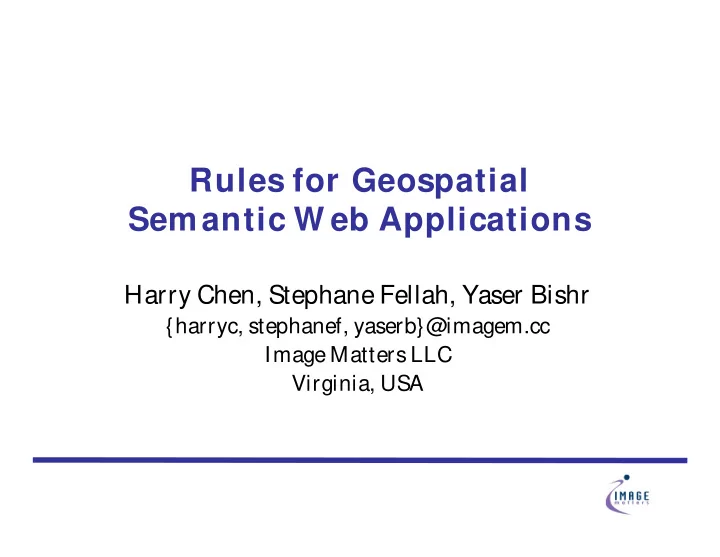

Rules for Geospatial Semantic W eb Applications Harry Chen, Stephane Fellah, Yaser Bishr {harryc, stephanef, yaserb}@imagem.cc Image Matters LLC Virginia, USA
2 Objectives • Describe the use of rules in Geospatial Semantic Web application • Discuss language requirements for expressing geospatial inference rules • Discuss tools requirements for processing geospatial inference rules • Highlight open questions associated with the use of rules in geospatial applications
3 Geospatial Semantic W eb • Geospatial Semantic Web is a natural extension of the current geospatial systems and applications • Key focuses • Enable data interoperability by exploiting semantic web languages and ontologies • Automate the production of geospatial knowledge by using rules and OWL inferences
4 An I ntelligence Analyst Application • Help intelligence analysts to solve problems using different types of geospatial knowledge • E.g. Discover WMD capabilities of a country by comparing the collected data with the known WMD signature information
5 Geospatial M odels Typically, we do reasoning in this world with rules!
6 Rules Usage Examples • Assumption: all geospatial data are expressed in OWL/ RDF based on some shared ontology • Enable data interoperability • Using rules to convert data from one geometry representation to another geometry representation • Using rules to unify Unit of Measurements • Automate geospatial knowledge production • Define rules for topological reasoning (e.g. Region Connection Calculus, Allen’s Interval Calculus) • Define rules for bridging geometry reasoning and topological reasoning
7 Rule Language Requirement • Support for N-ary representation • Not all geospatial relations are binary. • distanceFrom (?locA, ?locB, 200m) • Support for mapping data from the RDF representation to other rule engine specific representation • Classical rule engines may be needed to support default reasoning, fuzzy reasoning • It’s inconvenient to write rules that involve a large number of N-Triples
8 Rule Processing Requirement • When processing certain geospatial inference rules, a rule engine may be required to preprocess the associated rdf:Resource. • IF distanceFrom(?locA, ?locB, 200m) THEN do_some_work() • Must extract geometry information of the rdf:Resource that are bound to ?locA and ?locB • Integrate the representation of “functors” (built-ins) as RDF properties • (?geoA geo:within ?geoB) • (?a geo:within ?c) <- (?a geo:within ?b), (?b geo:within ?c) • If “geo:within” is a functor, what should be the caching policy, and when should the engine do triple evaluations rather than calling the functor?
9 Open Question: Contexts • Geospatial inference often involves context (location, time etc). • Rules for determining WMD facilities within a forest area might be different from those for determining WMD facilities within a desert area • Rules for determining WMD facilities during a winter season might be different from those for determining WMD facilities during a summer season • Should rule representation include constructs for context representation?
10 Open Question: Constraint Rules • Constraint rules are essential for geospatial representation and inference • E.g. The Helipad should be within the Security Fences of a potential WMD facility, and it should be at least 200 meters away from the fence • E.g. a potential WMD facility should not be within or partially within a flood plain. • Should there be special constructs for representing constraint rules?
Open Question: 11 W orking with I mprecise Data • An intelligence analyst rule: • Most WMD facilities are within 50Km of cities with populations equal to or greater than 10,000 population. • How to define rules that can tolerate imprecise data that is measured from the real world? • What if facility(X) is within 50.05 Km of a city with population 9,999? • How to define rules to deal with subjective concepts? • Nearby, far away, cold/ warm, soon, later etc.
Questions?
Recommend
More recommend